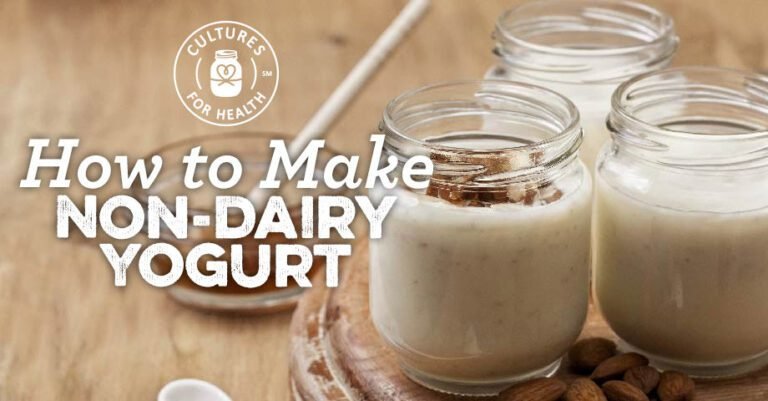How to make your own dairy-free yogurt
1. Choose your preferred non-dairy milk for your dairy-free yogurt
Almost any non-dairy milk can be cultured into vegan yogurt, including legumes, nuts, seeds, grains, and coconut milk. Although you can use commercially available boxed or canned milk, we recommend using milk with as few additives as possible. Homemade milk is well cultured and easy to make. Check out our collection of recipes for making homemade non-dairy milk.

Learn more: Milk Alternatives to Make Yogurt | Dairy-Free Yogurt Recipes
In addition to milk, vegan yogurt cultures require sugar for fermentation. Some types of milk alternatives have lower sugar content than cow’s milk. In this case, you may need to add about 1 1/2 to 2 teaspoons of sugar per cup of milk to ensure successful fermentation. The exception is rice milk, which is already high in carbohydrates. However, keep in mind that the added sugar will be consumed by the culture during fermentation and will not significantly increase the final sugar content of the yogurt.
2. Choose a vegan yogurt thickener
Non-dairy milk is cultured into non-dairy yogurt without thickeners and usually does not curdle. To make a fairly thick vegan yogurt that you can eat with a spoon, you need to choose a thickener that meets your dietary needs. Certain thickeners must be added to the milk before it is heated and before the culturing process, so be sure to review your options and choose your thickener before you start.
3. Choose a homemade vegan yogurt culture
Vegan yogurt starters are a great way to make yogurt recipes that are completely dairy-free. It’s available alone or as part of a vegan yogurt starter kit that includes a thickener and other supplies like Fairy Yogurt.
If small amounts of dairy are tolerated, other dairy-based yogurt starter cultures can be used as long as a pasteurized dairy mother culture is also maintained.
4. Find a vegan yogurt recipe that suits your tastes
Our Cultures for Health team developed these vegan yogurt recipes using a vegan yogurt starter and various thickeners. Start with a basic vegan yogurt recipe, but choose one of our other recipes, create your own combination of non-dairy milk, thickener, and starter culture, or use our vegan yogurt starter kit You can also. Step-by-step guide. Once you’ve tried the basics, you can experiment with different combinations to create your own perfect non-dairy yogurt.
You can experiment with different combinations of non-dairy milk, thickeners, and culture fluids to create a variety of delicious vegan yogurts, but don’t forget to note the proportions you use. Adjusting the amount can have a big impact on the final texture and taste of the yogurt. Also note that incubation times may vary depending on the type of milk and culture used. Remember, it may take some trial and error to achieve the perfect vegan yogurt.
5. Prepare supplies for making dairy-free yogurt
Most non-dairy yogurt recipes are best using homemade non-dairy milk. Cotton nut milk bags are suitable for straining nut milk. To make yogurt with a vegan yogurt starter culture, you will also need a yogurt maker or similar equipment. Finally, this basic supplies list for yogurt making outlines other yogurt supplies that are helpful to have on hand to make yogurt at home.
You’ll love our easy vegan yogurt recipe! Download the yogurt recipe book now. It’s easy to do, and all you need is a few key ingredients you probably already have in your kitchen. Plus, our yogurt guide has tons of delicious vegan yogurt recipes for you to try.
Easy dairy-free yogurt recipe
Vegan yogurt ingredients:
Diary free yogurt recipe:
Heat 1 to 2 quarts of non-dairy milk to 110°F.
Plant-based yogurt usually doesn’t thicken on its own. To make thick yogurt, mix two teaspoons of calcium-activated pectin and calcium water in milk and heat to 140 degrees. Cool to 110 degrees before adding culture.
Add 1 bag of yogurt starter and mix well. Pour the mixture into the culture vessel. Cover and incubate in a yogurt maker or similar device at 108-110°F for about 6-8 hours. After 8 hours, cover the container tightly and let it cool at room temperature for 2 hours. Refrigerate for at least 6 hours before eating.
Dairy-free yogurt has numerous health benefits, including probiotics that help maintain a healthy gut microbiome. Also, unlike store-bought yogurt, homemade yogurt allows you to control the ingredients and avoid preservatives and excess sugar. Adopting the habit of making your own vegan yogurt contributes to a healthier diet and a more sustainable lifestyle.

Special considerations when making your own vegan yogurt
Some alternative milks have added calcium. If you use Pomona’s pectin as a thickener, you may need to remove the calcium water in your recipe to avoid a yogurt that is too thick. Some alternative milks have less sugar than dairy products, so sugar can be added to speed up fermentation. A good guideline is 1 and 1/2 to 2 teaspoons of sugar per 1 cup of milk. Rice milk does not require additional sugar.
Interested in making vegan yogurt? Download our yogurt guide and recipe book now!



